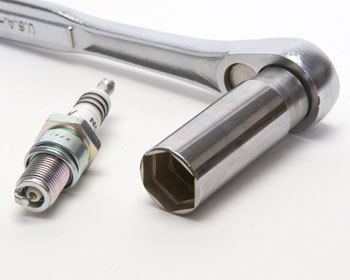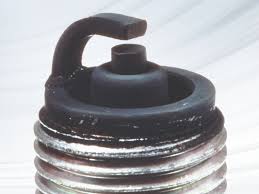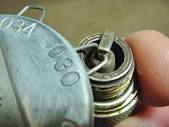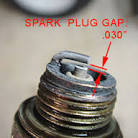PLUG LOCATION:
Spark plugs are located on the front or top of the engine and have an approximately 1/4" diameter heavy wire (usually black) connected to the top of each one.
There will be one spark plug for each engine cylinder. Most small engines only have one spark plug, twin-cylinder engines will have two spark plugs, four-cylinder engines will have four spark plugs..and so on...
The exact location and number of spark plugs will vary with engine style, size and manufacturer.
DETACHING THE WIRE BOOT:
There is a weather and temperature protective boot at the end of the spark plug wire covering the top of the spark plug.
Depending on the design of the engine, these protective boots may be made entirely of rubber (see pictures below) or a combination of insulating metal over rubber. The boots are pressed over the top of the spark plug and "snap-fitted" onto the top of the spark plug.
To access the spark plug for service the ENGINE MUST BE SHUT OFF AND ALLOWED TO COOL and then the protective boot on top of the spark plug will need to be removed.
DO NOT PULL ON THE WIRE ITSELF, as this may damage the wire or separate it from the boot assembly
Grasping the boot on the end of the wire and using a firm steady and slightly twisting back and forth pulling motion, a similar motion as to pulling a cork out from a bottle, carefully separate the boot end of the wire from the top of the spark plug.

*DETACHING THE WIRE BOOT
PLUG REMOVAL:
For spark plug service, the tool of choice is a ratcheting wrench with the proper size deep socket. The socket should be tall enough to slip down over the entire length of the plug and fit properly around the integrated retention nut at the base of the plug. Although a standard deep socket will work, tool companies also make "spark plug sockets", which have rubber inserts to protect the porcelain part of the plug from damage. The size of socket will vary with plug type and plug manufacturer. The most common sizes of spark plug nuts and the sockets used to remove/install them are 15/16", 13/16" and 5/8".
To remove the spark plug; slip the socket over the plug and rotate the wrench counterclockwise (lefty-loosey) until the plug comes loose and can be easily lifted away from the engine.

*SPARK PLUG & RATCHET W/DEEP SOCKET TOOL
PLUG VISUAL INSPECTION:
Inspect the plug for signs of black carbon deposits around the spark electrode at the bottom. Plugs with noticeable carbon build-up should be replaced with new plugs. Replacement spark plugs and tune-up parts are available at our Online Parts Store.

*CARBON DEPOSITS ON FOULED SPARK PLUG
NOTE: We do not recommend sanding or cleaning these carbon deposits, as this may damage the plug and any sand remaining on the plug may seriously damage the engine internal components. The cost-to-benefit ratio of installing fairly inexpensive new plugs, as compared to expensive engine damage and reduced engine performance, make cleaning and re-using plugs a risky practice.
ELECTRODE GAP:
The "spark" that ignites the fuel inside the engine arcs across a gap at the base of the spark plug between the spark plug electrode and an adjustable curved wire ground contact. This gap distance is a critical measurement to assure optimum spark efficiency and engine performance.
Use a Spark Plug Gap Tool to check the distance between the electrode and the contact. Although many new plugs may come with the gap pre-set, this setting is easily altered whenever a plug is not fully protected from contact. Properly adjust this gap as necessary by gently bending the curved ground contact until proper gap measurement is established.
The electrode gap on most small engine spark plugs should be set at 0.030 inches, but it is always best to verify this with the engine specification section in the Operator's Manual of the actual engine being serviced, as this gap setting may vary with engine style


*MEASURING GAP USING SPARK PLUG GAP TOOL
PLUG INSTALLATION:
* CAUTION: Always start plug installation by hand, not with the tool. It is recommended to use your fingers to start the process, to assure that the plug is properly aligned with the hole and threads. Improper thread alignment may cause serious damage to the engine and plug. Also, be careful not to bump the electrode on the firing tip end of the plug as you insert it into the hole, as doing so will likely result in the electrode gap closing and loss of proper gap adjustment.
Carefully insert the threaded end of the plug into the center of the hole and start the threads by turning the plug approximately one complete rotation clockwise (righty-tighty). Then use the ratchet tool to seat the spark plug snugly. The plug should seat completely and snug. Do not over-tighten the plug, as damage to the plug and/or engine may occur using excessive force.
Torque to 12-15 ft-lbs. ( 144-180 in-lbs. ).
Reconnect the wire and boot to the top of the spark plug by pressing down firmly until you feel a "snap", indicating that the wire boot is firmly reattached to the top of the spark plug.



